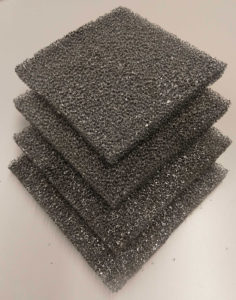Nowadays, sustainability is a key aspect when developing new materials, here the main focus is on ensuring the input materials used come from renewable sources and that the product is recyclable at the end of its service life. Researchers at the Fraunhofer Institute for Wood Research, WKI are developing wood foams made entirely of wood.
The natural adhesive properties of wood make synthetic adhesives superfluous. From an ecological standpoint, this makes wood foams ideal for a whole range of applications, for example as a core material for lightweight construction and sandwich panels, as packaging material, or for thermal insulation or soundproofing. In order to extend the application range of wood foam, a group of Fraunhofer Institute researchers led by Dr. Frauke Bunzel from Fraunhofer WKI developed a wood-metal foam hybrid that unites the properties of both wood foam and metal sponge. In the course of the project, they elaborated the principles for manufacturing the composite and determined its initial key properties, making it possible to classify it in relation to other materials. In follow-up projects, researchers will tailor the composite’s properties to selected applications. “Strengthening the wood foam with a metal skeleton, for example, can substantially enhance its characteristically low bending strength.”  In the case of HoMe foam, the bending strength of the hybrid is even greater than that of its two components. “That makes it an ideal core material for sandwich panels or as a self-supporting lightweight semi-finished material,” explains Dr. Bunzel. Another advantage is that, unlike wood foam, metal sponge can conduct electricity. The outstanding properties of wood foam are its high levels of sound absorption and low thermal conductivity, making it an excellent insulation material. Combining metal sponge and wood foam creates a lightweight hybrid material with a higher functionality, one that can be used for components that provide reinforcement and absorb sound. The material is thus suitable for use in the automotive industry, for example, as reinforcing acoustic mats in engine compartments or as floor plates. Other applications are conceivable too.
In the case of HoMe foam, the bending strength of the hybrid is even greater than that of its two components. “That makes it an ideal core material for sandwich panels or as a self-supporting lightweight semi-finished material,” explains Dr. Bunzel. Another advantage is that, unlike wood foam, metal sponge can conduct electricity. The outstanding properties of wood foam are its high levels of sound absorption and low thermal conductivity, making it an excellent insulation material. Combining metal sponge and wood foam creates a lightweight hybrid material with a higher functionality, one that can be used for components that provide reinforcement and absorb sound. The material is thus suitable for use in the automotive industry, for example, as reinforcing acoustic mats in engine compartments or as floor plates. Other applications are conceivable too.




